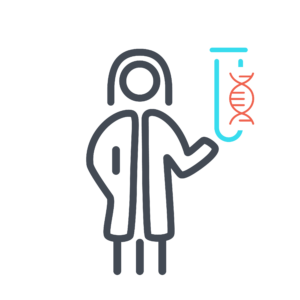NLGN2-Related Syndrome

Table of contents
- What is NLGN2-related syndrome?
- Key Role
- Symptoms
- What causes NLGN2-related syndrome?
- Why does my child have a change in the NLGN2 gene?
- What are the chances that other family members of future children will have NLGN2-related syndrome?
- How many people have NLGN2-related syndrome?
- Do people who have NLGN2-related syndrome look different?
- How is NLGN2-related syndrome treated?
- Behavior and development concerns linked to NLGN2-related syndrome
- Medical and physical concerns linked to NLGN2-related syndrome
- Where can I find support and resources?
- Sources and References
NLGN2-related syndrome is also called NLGN2-related neurodevelopmental disorder. For this webpage, we will be using the name NLGN2-related syndrome to encompass the wide range of variants observed in the people identified.
What is NLGN2-related syndrome?
NLGN2-related syndrome happens when there are changes in the NLGN2 gene. These changes can keep the gene from working as it should.

Key Role
The NLGN2 gene plays an important role in the development of connections in the brain.
Symptoms
Because the NLGN2 gene is important for brain activity, many people who have NLGN2-related syndrome have:
- Autism
- Lower than average muscle tone
- Developmental delay
- Intellectual disability
- Obsessive-compulsive disorder
- Anxiety
- Aggression
- Seizures
- Obesity
- Schizophrenia
What causes NLGN2-related syndrome?
NLGN2-related syndrome is a genetic condition, which means that it is caused by variants in genes. Our genes contain the instructions, or code, that tell our cells how to grow, develop, and work. Every child gets two copies of the NLGN2 gene: one copy from their mother’s egg, and one copy from their father’s sperm. In most cases, parents pass on exact copies of the gene to their child. But the process of creating the egg or sperm is not perfect. A change in the genetic code can lead to physical issues, developmental issues, or both.
Sometimes a spontaneous variant happens in the sperm, egg or after fertilization. When a brand new genetic variant happens in the genetic code is called a ‘de novo’ genetic variant. The child is usually the first in the family to have the genetic variant.
De novo variants can take place in any gene. We all have some de novo variants, most of which don’t affect our health. But because NLGN2 plays a key role in development, de novo variants in this gene can have a meaningful effect.
Research shows that NLGN2-related syndrome is often the result of a de novo variant in NLGN2. Many parents who have had their genes tested do not have the NLGN2 genetic variant found in their child who has the syndrome. In some cases, NLGN2-related syndrome happens because the genetic variant was passed down from a parent.
Autosomal dominant conditions
NLGN2-related syndrome is an autosomal dominant genetic condition. This means that when a person has the one damaging variant in NLGN2 they will likely have symptoms of NLGN2-related syndrome. For someone with an autosomal dominant genetic syndrome, every time they have a child there is a 50 percent chance they pass on the same genetic variant and a 50 percent chance they do not pass on the same genetic variant.
Autosomal Dominant Genetic Syndrome
Why does my child have a change in the NLGN2 gene?
No parent causes their child’s NLGN2-related syndrome. We know this because no parent has any control over the gene changes that they do or do not pass on to their children. Please keep in mind that nothing a parent does before or during the pregnancy causes this to happen. The gene change takes place on its own and cannot be predicted or stopped.
What are the chances that other family members of future children will have NLGN2-related syndrome?
Each family is different. A geneticist or genetic counselor can give you advice on the chance that this will happen again in your family.
The risk of having another child who has NLGN2-related syndrome depends on the genes of both biological parents.
- If neither biological parent has the same genetic variant found in their child, the chance of having another child who has the syndrome is on average 1 percent. This 1 percent chance is higher than the chance of the general population. The increase in risk is due to the very unlikely chance that more of the mother’s egg cells or the father’s sperm cells carry the same genetic variant.
- If one biological parent has the same genetic variant found in their child, the chance of having another child who has the syndrome is 50 percent.
For a symptom-free brother or sister of someone who has NLGN2-related syndrome, the sibling’s risk of having a child who has NLGN2-related syndrome depends on the sibling’s genes and their parents’ genes.
- If neither parent has the same genetic variant causing NLGN2-related syndrome, the symptom-free sibling has a nearly 0 percent chance of having a child who would inherit NLGN2-related syndrome.
- If one biological parent has the same genetic variant causing NLGN2-related syndrome, the symptom-free sibling has a 50 percent chance of also having the same genetic variant. If the symptom-free sibling has the same genetic variant, their chance of having a child who has the genetic variant is 50 percent.
For a person who has NLGN2-related syndrome, the risk of having a child who has the syndrome is about 50 percent.

How many people have NLGN2-related syndrome?
As of 2025, about 32 people with a genetic variant in the NLGN2 gene have been identified in medical research. This includes people who have a genetic variant of uncertain significance.

Do people who have NLGN2-related syndrome look different?
People who have NLGN2-related syndrome may look different. Appearance can vary and can include some but not all of these features:
- Larger than average head size or smaller than average head size
- Changes in facial features, which might not be the same in every person

How is NLGN2-related syndrome treated?
Scientists and doctors have only just begun to study NLGN2-related syndrome. At this point, there are no medicines designed to treat the syndrome. A genetic diagnosis can help people decide on the best way to track the condition and manage therapies. Doctors can refer people to specialists for:
- Physical exams and brain studies
- Genetics consults
- Development and behavior studies
- Other issues, as needed
A developmental pediatrician, neurologist, or psychologist can follow progress over time and can help:
- Suggest the right therapies. This can include physical, occupational, speech, or behavioral therapy.
- Guide individualized education plans (IEPs).
Specialists advise that therapies for NLGN2-related syndrome should begin as early as possible, ideally before a child begins school.
If seizures happen, consult a neurologist. There are many types of seizures, and not all types are easy to spot. To learn more, you can refer to resources such as the Epilepsy Foundation’s website: www.epilepsy.com/learn/types-seizures.

This section includes a summary of information from major published articles. It highlights how many people have different symptoms. To learn more about the articles, see the Sources and References section of this guide.
Behavior and development concerns linked to NLGN2-related syndrome
Very few people with pathogenic or likely pathogenic variants in the NLGN2 gene have been identified. The summary below includes people with a genetic variant of uncertain significance.
Speech and Learning
All people with a genetic variant in the NLGN2 gene had developmental delay or intellectual disability (ID), and some people had speech delays or impairment.
- 9 out of 9 people had developmental delay or intellectual disability (100 percent)
- 3 people had speech delays or impairment
Behavior
People with a genetic variant in the NLGN2 gene had behavioral issues, such as autism, self-injury behavior, anxiety, catatonia, and aggressive behavior.
- 2 people had an autism diagnosis
- 1 person had self-injury behavior
- 2 people had anxiety
- 1 person had catatonia
- 2 people had aggression
Brain
Some people with a genetic variant in the NLGN2 gene had seizures, low muscle tone (hypotonia), a smaller than average head size (microcephaly), or a larger than average head size (macrocephaly).
- 3 out of 7 people had seizures (43 percent)
- 4 out of 7 people had hypotonia (57 percent)
- 2 out of 6 people had microcephaly (33 percent)
- 1 out of 6 people had macrocephaly (17 percent)

A 2011 research study investigating genetic variants in a group of people diagnosed with schizophrenia found that 23 people with a genetic variant in the NLGN2 gene were diagnosed with schizophrenia in adulthood. The genetic variant was an NLGN2 missense variant. Some researchers think that missense variants in NLGN2 are associated with schizophrenia.
In a separate study, one person with an NLGN2 genetic variant of uncertain significance was diagnosed with bipolar disorder.

Medical and physical concerns linked to NLGN2-related syndrome
Growth
Some people with a genetic variant in the NLGN2 gene had obesity and a strong desire to keep eating even after eating a full meal (hyperphagia).
- 1 person had obesity
- 2 people had hyperphagia

Where can I find support and resources?
Simons Searchlight
Simons Searchlight is an online international research program, building an ever growing natural history database, biorepository, and resource network of over 175 rare genetic neurodevelopmental disorders. By joining their community and sharing your experiences, you contribute to a growing database used by scientists worldwide to advance the understanding of your genetic condition. Through online surveys and optional blood sample collection, they gather valuable information to improve lives and drive scientific progress. Families like yours are the key to making meaningful progress. To register for Simons Searchlight, go to the Simons Searchlight website at www.simonssearchlight.org and click “Join Us.”
- Learn more about Simons Searchlight: www.simonssearchlight.org/frequently-asked-questions
- Simons Searchlight webpage with more information on NLGN2: www.simonssearchlight.org/research/what-we-study/nlgn2
- Simons Searchlight NLGN2 Facebook community: https://www.facebook.com/groups/nlgn2

Sources and References
The content in this guide comes from published studies about NLGN2-related syndrome. Below you can find details about each study.
- Bay, H., Haghighatfard, A., Karimipour, M., Seyedena, S. Y., & Hashemi, M. (2023). Expression alteration of Neuroligin family gene in attention deficit and hyperactivity disorder and autism spectrum disorder. Research in Developmental Disabilities, 139, 104558. doi:10.1016/j.ridd.2023.104558
- Parente, D. J., Garriga, C., Baskin, B., Douglas, G., Cho, M. T., Araujo, G. C., & Shinawi, M. (2017). Neuroligin 2 nonsense variant associated with anxiety, autism, intellectual disability, hyperphagia, and obesity. American Journal of Medical Genetics Part A, 173(1), 213-216. doi:10.1002/ajmg.a.37977
- Shillington, A., Lamy, M., Vawter-Lee, M., Erickson, C., Saal, H., Comoletti, D., & Abell, K. (2021). Case report: Is catatonia a clinical feature of the natural progression of NLGN2-related neurodevelopmental disorder? Journal of Autism and Developmental Disorders, 51(1), 371-376. doi:10.1007/s10803-020-04531-2
- Sun, C., Cheng, M. C., Qin, R., Liao, D. L., Chen, T. T., Koong, F. J., Chen, G., & Chen, C. H. (2011). Identification and functional characterization of rare mutations of the neuroligin-2 gene (NLGN2) associated with schizophrenia. Human Molecular Genetics, 20(15), 3042-3051. doi:10.1093/hmg/ddr208
- Zhao, S., Yang, L., Liang, L., Zheng, Y., Wang, Y., & Wang, D. (2023). A child with febrile and atypical absence seizures caused by a NLGN2 variant. Seizure, 111, 36-38. doi:10.1016/j.seizure.2023.07.014
